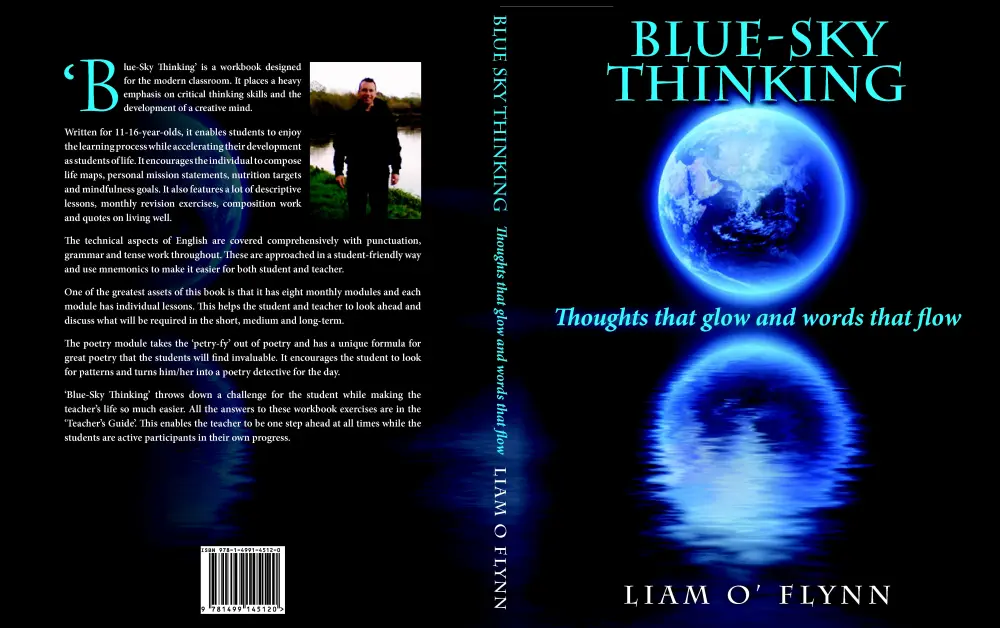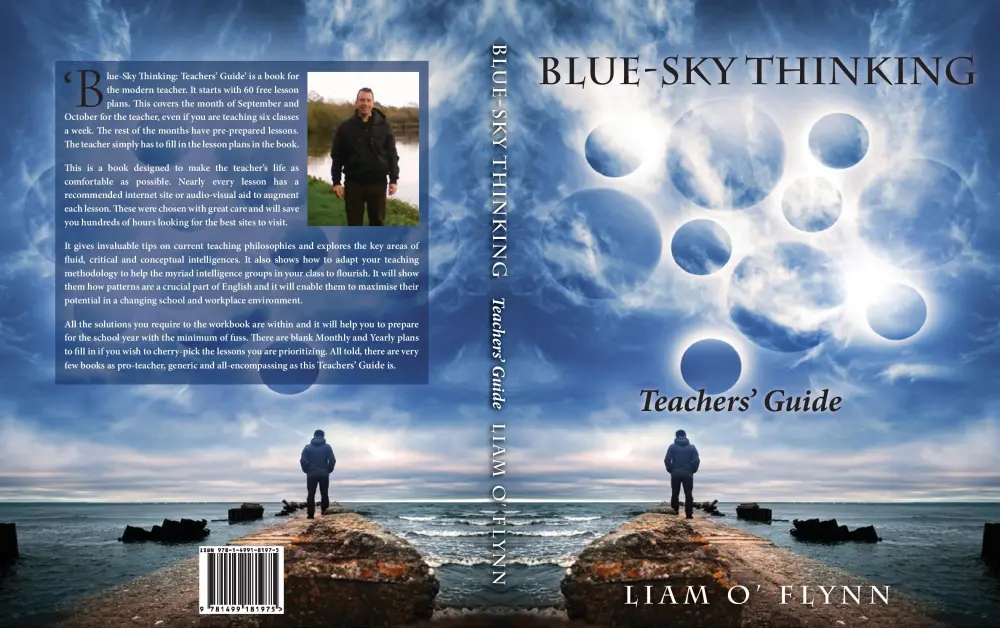Teaching descriptive writing is a craft and in this post I hope to show you how. The PDF document below entitled ‘Teaching descriptive writing’ has a number of grids and exercises for the students to accomplish.
The most important part of descriptive writing teaching is finding the pattern for each different scene. This makes it easy for the student to grasp it and actually engenders creativity. As Ernest Hemingway said: “Prose is architecture, not interior design”. By this he meant that all great writing should have a structure. Nature has a structure. It has colour, sound, sensation, smell and taste (or action/inaction if not). By using the grid system, in this case ‘Describing a beach’, you are showing the students a pattern that will make it easier for them to remember. Because their creativity is rewarded with a points structure, they are also having fun!
There are free lesson plans with this PDF document also. It is from my new book, ‘Blue-Sky Thinking’ and the solutions are from ‘Blue-Sky Thinking: Teachers’ Guide’. I hope you enjoy the post and just click on the blue writing below entitled ‘Teaching Descriptive Writing’ to view it:
TEACHING DESCRIPTIVE WRITING
Just click on any of the book cover images to see them on Amazon.




The best creative books for 11-16 year olds should have a mixture of the following: enabling their creativity to bubble up to the surface, to allow them to see the patterns in English, to provide a pedagogical approach which they will enjoy, to increase their fluid, critical and linguistic intelligences and, finally, to provide a platform for lifelong learning. This book, called ‘Blue-Sky Thinking’ will have this and much more.

It focuses in on punctuation in a student-friendly way. It also includes exercises on nutrition, personal and mission statements, Latin proverbs on living well, quotes from the most successful people who have ever lived and the metacognitive art of thinking how to think (appropriate to their age). It also has a poetry module that gives them a fool-proof method from which they can analyse all poems through the prism of technique.
Ostensibly, it is a book designed for the new Junior Cycle Student Award in Ireland. However, because of its unique structure, I am hoping English teachers in other countries can take something from it also. It has a Workbook and a Teachers’ Guide. The Teachers’ Guide shall include two months of lesson plans (September/October) and it may suit new teachers, as the plans are very comprehensive. The rest of the months contain lesson plans for teachers to fill in as they go, making it perfect as a book which dovetails with Inspectorate requirements.

It is available to buy on Amazon from May 23rd, 2014 and I will price it as cheaply as I can, as I did with my descriptive book and workbook, ‘Writing with Stardust’ (available to see here: Writing with Stardust ).

Here is just a snippet from it. It is just a story about The Battle of Stamford Bridge. From that, the students can decide what project they wish to do on the development of the English language and the cultures that shaped it: The Celts, Romans, Angles, Saxons, Jutes, Vikings, Normans, etc.
I will upload other snippets from ‘Blue-Sky Thinking’ soon.
THE HISTORY OF THE ENGLISH LANGUAGE
It is September 25th and the Battle of Stamford Bridge is underway. It is not Chelsea versus Arsenal. The screams and war cries of men fill the length of the meadow. The smoke is thick from fire arrows and they fizz and frizzle as they whine through the air. Steel rings, swords bite and men die.
The flowers are still fresh on the grave of Edward the Confessor, but the battle to be the next king of England has started. On one side of the river is the Anglo-Saxon army led by Harold Godwinson, the new English king. He has 7,000 men, but they are exhausted. They have just marched an incredible 185 miles in 4 days to get here. They were carrying heavy armour on this miracle march and it has taken its toll. The year is 1066.
On the other side of the river is the Viking army of Harald Hardrada, King of Norway. He has 10,000 men. Unfortunately, the other half of his army is a day’s march away, so only 5,000 are with him. They are resting up on their 300 ships as no one expected Godwinson to get here so soon. The bad news for Harald is that most of the armour is back with the ships as well. This September has been unnaturally hot and the men were happy to discard their armour. The sun beats down on their bare flesh as they lounge around, laughing and donkey calling each other.
Godwinson’s army streams up from the south and the Vikings are stunned. How did he manage to arrive so quickly? Although his men are bone tired, Godwinson launches into battle. The Vikings on the west side of the bridge are quickly overcome by the front of Godwinson’s army. The rest flee over the bridge and gather more forces. They stop to get weapons and what armour they can. Then they face Godwinson’s army again. This time they will fight on the bridge. The bridge has only enough room for 4 men across and that suits the big, bloodthirsty men of the North.
An hour later, Godwinson shouts out: “In the name of all that’s holy, what is happening up there?”
He knows the Vikings have sent word to the ships and that more men are on the way. It is vital that they get over the bridge and defeat this half of the Viking army before the reinforcements come. It is a lot easier to defeat 5,000 men in two separate battles than 10,000 in one. His horse is jittery but he reaches up on his stirrups and strains his neck to see. There must be a hundred of his men pressed together on the bridge. They are fighting in deadly hand-to-hand-combat and the sounds drifting back to him are sickening: bones cracking, shields splitting and flesh slicing. Then he sees what the holdup is.
There is one man on the bridge who is a head taller than the next tallest man. He is a titan of a man, a true giant, and he is causing havoc. This man would not have put on his armour even if he had it. He is a Viking berserker, a special breed of warrior who doesn’t care whether he lives or dies. His berserker name comes from two Norse words, ‘berr’ (bare) and ‘serkr’ (shirt). He is the lunatic on the bridge and, besides the battle axe he wields, he also has the fate of the English language gripped in those huge, clumpy paws of his….
THE BERSERKER ON THE BRIDGE
His axe smoked with steam and blood. He was weary beyond measure but they kept coming. The Vikings around him had withdrawn from the bridge because he was swinging his weapon in such huge arcs. He was also blood-drunk and they knew better than to be around him.
The world had narrowed down to two slits in the helmet he wore. It was an old bear skull fitted with metal plates and his father’s father had worn it before him. He was proud of his ancestors. He wanted to meet them with pride in his heart when he walked to the gates of Valhalla. That would be today, he knew, but he did not mind. He was born for this life of fighting and he would die well today no matter what happened.
His great chest heaved like a bellows as he drew in horse-breaths of air. The English dogs were moving back from the bridge! Then he saw the size of the men who were replacing them. His heart sank as he realised they were sending all their champions at once to face him. He knew his time was short so he took one last look around.
The trees were a-fire in a patchwork of colour and the light-haze of the sun on the corn was spectacular. Then the sun dimmed behind the hills and the Technicolor faded. COLOUR
The noise of battle turned down like a switch as the two armies waited to see what would happen. A Viking titan fighting against the best of the Saxon army. A pin drop silence descended. There was no insect-hum, no leaf-rustle, no wind-music. SOUND
He touched the cold, smooth steel of his axe head as he sharpened the edge of the blade with his whetstone. It felt like pond ice. He laughed at the memory of his father falling into the frozen pond when the snow dragon had come in May all those years ago. TEXTURE
The memory released his tension and he inhaled the sweet, September air for the last time. Above the stench of horse bowels and blood, pollen drifted in the air. Air gold, the Viking women called it, but gold didn’t smell of red poppies and white lilies. SMELL
The Saxon champions were ready. The last one was clomping up in his battle boots and they were forming in line to face him. He looked down and saw a sleek trout lazing in the river. Its spots were blue and red and white and he knew he would look like that tonight. IMAGE
He only knew one Latin phrase. His son in Norway had it now. It was hundreds of years old and it was engraved on a Roman coin. It was a metaphor for how his family had lived its life. “Melium est nomen bonum quam divitae multae,” he whispered and charged up the bridge. “Will I be remembered?” he wondered, as he swung his axe in frenzy. Voices rang, swords sang and men died. METAPHOR
Find out what happened next by typing it into Google. Then write the ending once you get all the facts. What is for certain is that the Battle of Stamford Bridge had the potential to change the direction of the English language. Less than 3 weeks later, the winner of this battle fought the king of France in the Battle of Hastings to see who would rule England for once and for all. You should consider doing a project on these battles and relating them to English class.




